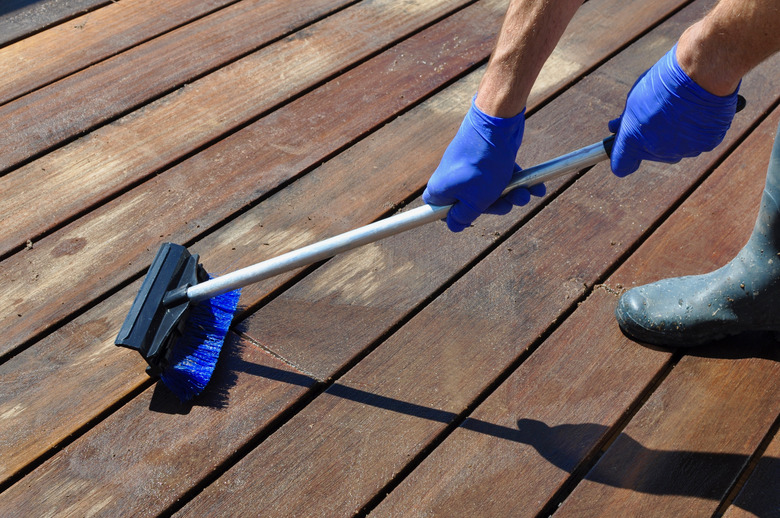How To Clean A Wood Deck With Sodium Percarbonate
We may receive a commission on purchases made from links.
Sodium percarbonate is a combination of sodium carbonate, also known as washing soda, and hydrogen peroxide. The sodium percarbonate formula is written as C2H6Na4O12 or 2Na2CO3.3H2O2. When the white, odorless powder is dissolved in water, it breaks down to its components, making it a powerful bleaching, oxidizing, and disinfecting agent in a variety of cleaning products, including dishwasher detergents, oxygen bleach products, and deck cleaners. As a deck cleaner, a sodium percarbonate solution removes algae and mold stains as it loosens the dirt and grime on the wood decking boards.
Sodium Percarbonate Uses
Sodium Percarbonate Uses
The many uses of sodium percarbonate include its incorporation into a wide range of cleaning products, such as Kirkland dishwasher pacs, OxiClean, Stain Solver, and Tide laundry detergent. While it is only one ingredient among many in most cleaning products, sodium percarbonate is also available as a single-ingredient item that you can mix with hot water to clean and disinfect laundry, countertops, the cat's litter box, carpets, and other items inside and outside the home.
When using pure sodium percarbonate powder, a little goes a long way. For example, instead of 1/2 cup of oxygen bleach, use 2 tablespoons of sodium percarbonate along with your normal bleach-free laundry detergent to wash a full load of laundry. Use caution to avoid breathing the powder and wear gloves and safety goggles when mixing and using sodium percarbonate solutions.
General Cleaning Guidelines
General Cleaning Guidelines
Mix a sodium percarbonate and water solution for cleaning indoors and outdoors. One-half cup of sodium percarbonate powder mixed with 1 gallon of hot water makes a general cleaning solution; double the amount of sodium percarbonate to make a heavy-duty cleaning solution. Spot test the cleaning solution on carpets, fabrics, and upholstery to ensure the solution doesn't damage or remove the dye from the materials.
While warm or hot water is recommended when mixing a sodium percarbonate solution to ensure that the powder fully dissolves, use a cold solution when removing blood or grass stains. Mix the powder with half the normal amount of hot water and stir to dissolve. Then, add cold water or ice cubes to cool the solution before applying it to the stain.
If the label instructions call for ounces in measuring the product, 1 ounce of dry powder is equal to 2 tablespoons. Four tablespoons is equal to 1/4 cup, so if the instructions call for 2 ounces of powder, use 1/4 cup of powder. Do not try to store the solution after mixing; use it within six hours and then discard any remaining solution.
Deck Cleaning and Sodium Percarbonate
Deck Cleaning and Sodium Percarbonate
Before you prepare the sodium percarbonate solution, remove deck furniture, flowerpots, and decor. Sweep the deck to remove dirt, debris, and leaves. Avoid using sodium percarbonate solutions or other deck cleaning products when temperatures are below 50 degrees or above 85 degrees Fahrenheit. In addition, the solution may remove damaged stains and sealants, so test an inconspicuous spot before applying it to the entire deck.
Mix 1/2 to 1 cup of powder per gallon of hot water in a hand pump sprayer. Saturate the deck with the solution and allow it to soak in for up to 30 minutes; add more solution if necessary to keep the deck wet. Scrub with a stiff deck brush or broom to loosen and remove stains and dirt. Rinse with a garden hose and allow it to air-dry.
This cleaning solution can also be used to clean bricks, concrete, fencing, siding, and stucco. While a pressure washer helps remove stains on concrete, avoid using it on wood decking or siding, as it can damage the wood fibers and/or drive water behind the siding.
